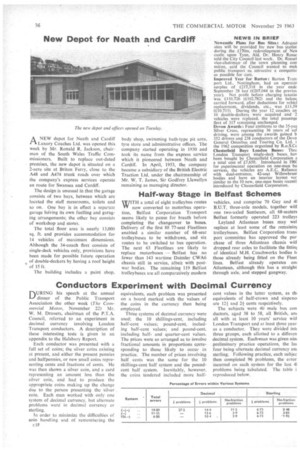Conductors Experiment with Decimal Currency
Page 38

If you've noticed an error in this article please click here to report it so we can fix it.
DUR1NG his speech at the annual dinner of the Public Transport Association the other week (The Commercial Motor, November 22) Mr. W. M. Dravers, chairman of the P.T.A. Council, referred to an experiment in decimal currency involving London Transport conductors. A description of these interesting tests is given in an appendix to the Halsbury Report.
Each conductor was presented with a full set of coins; the silver coins existing at present, and either the present pennies and halfpennies, or new small coins representing cents and fractions of cents. He was then shown a silver coin, and a card representing an amount less than the silver coin, and had to produce the appropriate coins making up the change due to the person presenting the silver coin. Each man worked with only one system of decimal currency, but alternate problems were in decimal currency or sterling.
In order to minimize the difficulties of coin handling and of remembering the c18
equivalents, each problem was presented on a board marked with the values of the coins in the currency then being employed.
Three systems of decimal currency were used; the 10 shillings-cent, including half-cent values; pound-cent. including half-cent values; and pound-cent, including halfand quarter-cent values. The prices were so arranged as to involve fractional amounts in proportions corresponding to those likely to occur in practice. The number of prices involving half cents was the same for the 10 shillings-cent half system and the poundcent half system. Inevitably, however. the coins tendered included more half cent values in the latter system, as thi equivalents of half-crown and sixpeno are 121 and 21 cents respectively.
The subjects. were 40 male bus con ductors, aged 38 to 58, all British, arn all with at least 10 years' service will London Transport and ar least three year as a conductor. They were divided inn three groups, each allotted to a ditieren decimal system. Each 'man was given nim preliminary practice operations, the las four being alternate decimal currency am sterling. Following practice, each subjec then completed 96 problems, the error incurred on each system for the last 41 problems being tabulated. The table i reproduced below.








































































































